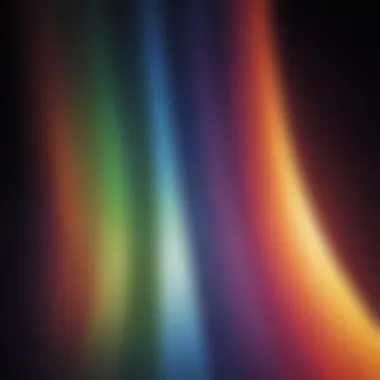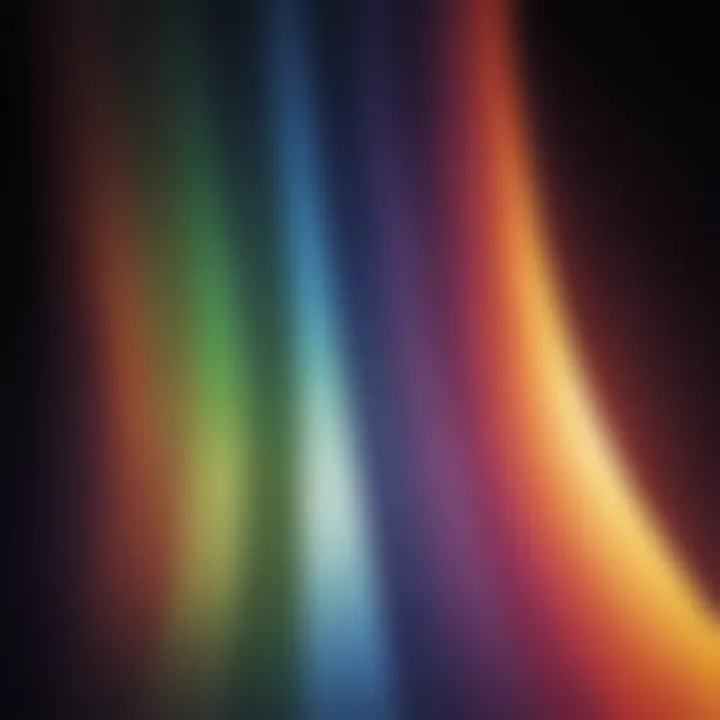Illuminating the Path: Understanding Light in Projects


Intro
Light is an essential component of our world, and it significantly influences various aspects of projects. Understanding the principles of light can inspire creativity and enhance problem-solving skills. This article examines the different types of light sources, the nature of light itself, and how we can effectively incorporate light into various projects, engaging young learners in scientific exploration. By exploring the complexities of light, we aim to spark curiosity and encourage practical applications in everyday activities.
Science Fun Facts
Interesting Trivia and Facts
- Light travels fast. In a vacuum, light speed is about 299,792 kilometers per second. This means if you were to turn on a flashlight, the light would reach the stars in no time.
- The visible spectrum is narrow. Humans can see only a tiny fraction of the electromagnetic spectrum, specifically between wavelengths of 400 and 700 nm.
Quirky Science Stories
Did you know that some animals can see ultraviolet light? For example, certain species of bees can see patterns on flowers invisible to the human eye. These patterns, known as nectar guides, help guide the bees to the pollen.
Amazing Science Records
The longest continuous exposure to light was recorded in 1838 by the French scientist Nicephore Niepce. He created the first permanent photograph using a camera obscura, showcasing the potential of light in photography.
Thought-Provoking Questions
- What would happen to our planet if the sun suddenly disappeared?
- How does light affect our mood and behavior?
Discover the Wonders of Science
Exploring Various Scientific Concepts
Light is not just a tool; it is a phenomenon with many fascinating properties. Reflection, refraction, and dispersion are key concepts that help in understanding how light behaves in different mediums.
Educational Videos and Animations
There are excellent resources, such as Khan Academy and TED-Ed, that provide animated videos about how light travels and interacts with objects. These platforms make the learning process engaging and informative.
Interactive Learning Tools
Apps like Star Walk or SkySafari can help students explore the night sky, learn about constellations, and understand how light pollution affects our view of the stars.
Real-Life Applications of Science
Consider how engineers use light in designing smart homes. Systems like Philips Hue allow for adjusting light intensity based on the time of day, which can improve our overall well-being.
Science Quiz Time
Interactive Quizzes
Why not test your knowledge about light? Websites like Quizlet offer various quizzes focused on different aspects of light.
Multiple Choice Questions
- What is the speed of light in a vacuum?
- A) 300,000 km/s
- B) 150,000 km/s
- C) 700,000 km/s
Correct answer: A
Brain Teasers and Puzzles
Imagine you have a prism. If you shine light through it, what colors will you see come out? This is a fun way to demonstrate dispersion.
Learning Through Gamification
Games that involve light puzzles, such as Glow or Laser Break, can make learning enjoyable while imparting essential scientific principles.
Science Experiment Showcase
Fun and Engaging Experiments
Creating a solar oven or a simple spectroscope can illustrate the principles of light and warmth.
Step-by-Step Instructions
For a solar oven:
- Gather materials like a pizza box, aluminum foil, and plastic wrap.
- Cut a flap in the lid and line it with foil, then place black paper at the bottom.
- Use plastic wrap to cover the opening, trapping heat inside.
- Test with s'mores on a sunny day.
Materials List
- Pizza box
- Aluminum foil
- Plastic wrap
- Black paper
- Food items to cook


Safety Tips and Precautions
Always handle sharp tools carefully when preparing materials for experiments.
Understanding light is crucial for many scientific fields, including physics, biology, and engineering. It impacts our daily lives in numerous ways, from how we see to how we communicate.
Learning about light offers endless opportunities for exploration and creativity. As we enrich our understanding, we can approach projects with renewed curiosity and innovation.
The Science of Light
The exploration of light is fundamental in understanding various phenomena. Light is not just a source of illumination; it can influence scientific experiments, artistic expressions, and technology. By understanding the science of light, readers can apply this knowledge to different projects, enriching their learning experience.
The study of light covers multiple aspects, from its definition and speed to its properties. Each element plays a significant role in how light interacts with various materials and how we perceive it. Understanding light empowers individuals, especially young learners, to dive deeper into scientific inquiry and creative exploration.
What is Light?
Light is a form of energy that travels in waves. It can be visible or invisible to the human eye. Visible light is the small part of the electromagnetic spectrum that we can see. Light allows us to see the world around us. Without light, there would be no colors, no images, and no life as we know it.
Light is essential for various processes, such as photosynthesis in plants. It is also vital in different technologies, including cameras and lasers. The role of light has a vast impact across different fields, making its understanding crucial in projects.
The Speed of Light
The speed of light in a vacuum is approximately 299,792 kilometers per second. This is the fastest speed at which information can travel in the universe. Understanding this speed is essential in many scientific areas such as physics and astronomy.
For practical applications, measuring the speed of light provides insight into distances in space. When scientists observe stars and galaxies, they use light years, which is the distance light travels in one year. This perspective helps us comprehend the vastness of the universe.
Properties of Light
Light possesses distinct properties that are critical in many contexts. These properties influence how we use light in projects. Three essential properties are Reflection, Refraction, and Diffraction.
Reflection
Reflection occurs when light bounces off a surface. This property allows us to see our images in mirrors and water. Reflection is crucial in projects that involve imaging and surface analysis.
One key characteristic of reflection is that it follows the law that states the angle of incidence equals the angle of reflection. This predictable behavior makes reflection a beneficial choice in educational activities, like learning about angles and optics. However, not all surfaces reflect light equally; shiny, smooth surfaces reflect better than rough ones.
Refraction
Refraction is the bending of light as it passes from one medium to another. This property causes objects underwater to appear distorted. Refraction is important in understanding lenses in glasses, cameras, and microscopes.
The key feature of refraction is that it changes the speed of light depending on the medium. This aspect makes it beneficial for projects that require magnification or precise imaging. However, miscalculating angles during refraction can lead to optical illusions, complicating observations.
Diffraction
Diffraction occurs when light waves bend around obstacles or spread as they pass through narrow openings. This property is significant for understanding sound and light waves. Diffraction explains why we can hear music around a corner or how light spreads into a rainbow.
One defining characteristic of diffraction is that it causes light to form patterns. This feature is especially fascinating in photography and optical experiments. Its disadvantage lies in making precise images sometimes unclear due to the spread of light, which can pose challenges in certain projects.
Types of Light Sources
Understanding the various types of light sources is essential for anyone embarking on projects involving light. Each source has unique characteristics, benefits, and considerations that affect how light can be utilized. This section will address the major types of light sources: natural light and artificial light. Both types serve important purposes in projects, each with advantages and disadvantages.
Natural Light
Natural light, primarily from the sun, plays a crucial role in our lives. It is abundant, free, and provides essential illumination for numerous applications.
The Sun
The sun is the largest source of natural light. Its rays reach Earth and illuminate our surroundings. A key characteristic of the sun is its ability to provide full-spectrum light. This means it includes all colors of light, which is beneficial for plants and animals. In projects, natural light can enhance the mood and atmosphere. For instance, artists often use sunlight to achieve vibrant colors in their work.
However, natural light can be unpredictable. Weather conditions can obscure sunlight, making it challenging to rely on consistently. Additionally, the intensity of sunlight varies throughout the day and across seasons, which may require adjustments in how projects are planned.
Bioluminescence
Bioluminescence is another fascinating form of natural light. It is produced by living organisms, such as fireflies and certain types of jellyfish. This creates a soft, glowing effect that can be mesmerizing. The key characteristic of bioluminescence is its ability to emit light without heat, making it a unique option for projects focused on sustainability and nature.
The advantage of bioluminescent organisms is their low energy cost and ecological harmony. However, this source is limited to specific locations and conditions. For project applications, using bioluminescence may require specific environments or may not be feasible in all areas.
Artificial Light
Artificial light refers to light produced by human-made sources. These sources can be used to brighten spaces and enhance projects in creative ways. Popular options include incandescent bulbs, LED lights, and laser beams.
Incandescent Bulbs
Incandescent bulbs are one of the oldest forms of artificial lighting. They work by passing electricity through a thin filament, which then glows and produces light. A key characteristic of incandescent bulbs is their warm light, which many find pleasing for homes and artistic setups.


However, these bulbs consume a lot of energy and generate significant heat, which can be a disadvantage. They have a shorter lifespan compared to newer options. Still, they can be suitable for projects where a warm ambiance is desired.
LED Lights
Light Emitting Diodes, commonly known as LED lights, are a popular choice in modern projects. These lights are highly energy-efficient and have a long operational life. Their main characteristic is that they provide bright, clear light while consuming much less power than traditional bulbs.
LED lights are versatile and come in various colors and sizes, making them ideal for creative applications. However, the initial cost may be higher than incandescent bulbs, which can be a consideration for smaller budgets.
Laser Beams
Laser beams represent a more advanced artificial light source. They work by amplifying light through stimulated emission. The light produced is focused and can be very powerful. The key characteristic of laser beams is their precision and ability to reach long distances without much dispersion.
Laser technology has numerous applications, especially in fields like medicine and manufacturing. However, the safety aspects are significant. Direct exposure to laser beams can cause serious damage to the eyes and skin. For this reason, using lasers in projects must be carefully managed to ensure safety.
Understanding Color and Light
Understanding color and light is crucial for grasping not only the science behind visual experiences but also how light influences creativity in various projects. This section will detail the essence of color, how it interacts with light, and its implications for artistic and scientific endeavors.
The interplay between color and light offers a framework for numerous applications. It helps in creating visual effects that capture attention and communicate meaning. For younger learners, awareness of color and light can spark curiosity and enthusiasm about scientific principles. Moreover, understanding these concepts enables learners to harness the power of light in their creative projects effectively.
The Visible Spectrum
The visible spectrum represents the range of colors that the human eye can perceive. It is essential in many projects, especially those focused on art, design, and science. By understanding the visible spectrum, individuals can explore how different colors result from specific wavelengths of light.
Primary Colors of Light
The primary colors of light are red, green, and blue. These colors are fundamental because they can be mixed together in various combinations to create a wide variety of other colors. This characteristic makes them a popular choice in this article. For example, combining red and green light creates yellow, while green and blue light produce cyan.
Key Characteristic: The unique feature of primary colors of light is their ability to blend in additive ways. When combined fully, they produce white light, which is beneficial in both scientific applications and everyday life, such as computer screens and theaters. This aspect illustrates how light can be manipulated and utilized in creative ways.
Mixing Colors
Mixing colors further extends the idea of using primary colors of light. When different colors of light are combined, they create a new hue. This process is known as additive color mixing and is crucial for understanding color theory in various projects. For instance, understanding how colors mix can help in creating visually appealing designs or effective lighting for performances.
Key Characteristic: The importance of mixing colors lies in its practical applications. Artists and designers often rely on this to achieve desirable results in their work. By grasping how to mix colors well, learners can enhance their projects significantly. The unique aspect is that mixing colors in light differs from pigment mixing ever used in painting, where subtractive mixing occurs.
Color Perception
Color perception is the way humans interpret colors through the interaction of light and the retina. This process is subjective and varies from person to person. Variations in perception can be influenced by lighting conditions, surrounding colors, and even personal experiences.
Understanding color perception is vital for any project that involves visual elements. It allows creators to consider how their audience will interpret colors and shapes. By researching color theory and perception, learners can design more effective projects that resonate with others.
In summary, a comprehension of color and light creates opportunities for creativity and scientific exploration. Both aspects are interconnected and immensely relevant when undertaking any project that involves visual phenomena.
Light and Its Applications in Projects
Light plays a crucial role in various projects, enhancing both creativity and understanding of scientific concepts. Its applications bridge the gap between theory and practice, making it an ideal subject for exploration in educational settings. Projects that involve light promote engagement and curiosity, allowing young learners to experience firsthand the properties and behaviors of light. These projects not only cultivate scientific inquiry but also encourage innovation.
Lighting in Experiments
Basic Science Experiments
Basic science experiments that involve light serve as foundational activities in the understanding of light's nature. They contribute significantly to the overall topic by providing hands-on experiences. Such experiments often include simple tasks, like creating shadows or observing how light passes through various materials. These activities highlight the key characteristic of direct interaction with light, allowing students to grasp concepts like reflection, refraction, and absorption.
One unique feature of basic science experiments is their accessibility. Many of these experiments require minimal materials, making them a beneficial choice for classroom settings or home activities. The advantages of these experiments include fostering a concrete understanding of light principles while being enjoyable and engaging. However, a disadvantage can be that they sometimes neglect deeper explorations of light's complex properties.
Creative Projects
Creative projects that utilize light can enhance artistic expression while reinforcing scientific principles. These projects often involve crafting light displays or creating artwork that incorporates light sources. A key characteristic of creative projects is their focus on personal interpretation, allowing for individual creativity. They are particularly popular because they blend science with art, making learning enjoyable and relatable to diverse audiences.
The unique feature of creative projects lies in their endless possibilities. Students can experiment with colors, shapes, and different light sources to create their designs. The advantage is that these projects can lead to discussions about optics and design principles, awakening interest in both fields. On the downside, they may require more resources and preparation time than basic experiments, which could be a consideration for educators.
Using Light in Art
Photography
Photography represents a fascinating application of light, showcasing its power to capture moments and tell stories. This aspect contributes substantially to the overall topic by emphasizing how light can influence perception. The key characteristic of photography is the manipulation of light and shadow, which can dramatically change the mood and impact of an image.
A unique feature of photography is the necessity of understanding light conditions, such as bright and dim settings. Photographers learn to master different light sources and angles, which aids in creating impactful visuals. The advantages include the ability to create beautiful artworks and the potential for self-expression. However, it may require specific skills and equipment, which can be barriers for beginners.
Light Installations
Light installations are an innovative way to explore the use of light in a more extensive visual context. They can be used in public spaces, galleries, or exhibitions, making a statement about art and science. The contribution of light installations to the overall topic is significant, as they meld technology with creativity, showcasing what can be achieved when art and science converge.
The key characteristic of light installations is their immersive nature. They can engage viewers on multiple sensory levels, encouraging interaction. This unique feature promotes a dynamic experience, offering both aesthetic and educational value. The advantages include raising awareness about light and its properties, but they can also pose challenges in terms of logistics and planning.


"Light transforms our understanding of the world, bridging the gap between observation and imagination."
Safety Considerations
Understanding light is fascinating, but it also brings responsibilities. Safety is a vital topic when working with light sources. Various light sources provide benefits but can also pose risks if not handled properly. This section will explore the safety measures necessary for both young learners and adults.
Working with Light Sources
Working with light sources is common in many projects. Each type of light source comes with its own set of considerations. For instance, incandescent bulbs generate heat, which can cause burns or create fire hazards. LED lights often have much lower heat output, making them safer in many situations.
Some key points to remember include:
- Always check the wattage and voltage ratings of bulbs to avoid overloads.
- Ensure that the electrical connections are secure to prevent sparks.
- Don’t touch light sources immediately after use, especially if they have been on for a long time.
When young learners are involved, adult supervision is essential. Children may be curious, leading them to touch or handle items that may not be safe. Teaching them to ask questions is a proactive approach to their safety. As they engage in projects, instilling habits of caution and awareness can prevent mishaps.
Protective Measures
To enhance safety while working with light, protective measures are crucial. Here are some considerations:
- Protective Eyewear: When using strong light sources, like lasers, goggles can safeguard the eyes from potential damage.
- Heat-Resistant Gloves: These can protect hands while handling hot light sources or equipment.
- Stable Setups: Ensure that lighting equipment is securely placed to prevent it from falling and causing injury.
Safety should never be an afterthought. Preparing for any situation is key to a successful project.
It's important to include a first aid kit nearby. Accidents can happen despite best efforts. Be prepared to address minor injuries quickly. Teaching children about the importance of safety measures can be a valuable lesson. They learn not just about light, but also the responsibility that comes with experimentation.
Innovative Uses of Light
The innovative uses of light represent a significant area of exploration that reveals the interconnectedness of science, technology, and daily life. These applications not only highlight the versatility of light but also its fundamental role in driving advancements across various fields. Understanding how light is harnessed in technology and biology fosters a deeper appreciation of its impact and implications. This section delves into how unique aspects of light contribute to creation and innovation.
Light in Technology
Optical Fibers
Optical fibers are strands of glass or plastic designed to transmit data in the form of light. This transmission method is crucial for the development of high-speed communication systems. One key characteristic of optical fibers is their ability to carry large amounts of information over long distances with minimal loss. This makes them a popular choice for internet and telecommunications industries.
The unique feature of optical fibers involves total internal reflection, allowing light to be guided even through curves in the fibers. Their advantages include high bandwidth, immunity to electromagnetic interference, and low susceptibility to signal degradation compared to traditional copper wires. However, they can be more brittle and may require careful handling to avoid damage, which can limit their use in some applications.
Displays
Displays encompass a wide variety of technologies that convert electrical signals into visual representations. They are integral to smartphones, televisions, and computer screens. One notable characteristic of displays is their ability to produce bright, vivid colors, which enhances user engagement and accessibility to information.
A unique aspect of many modern displays is the use of LED technology, ensuring lower power consumption and longer lifespan. The advantages of displays include clarity, versatility, and interactive capabilities, making them ideal for educational purposes and entertainment. However, some displays can cause eye strain, and the production process may contribute to environmental concerns.
Biotechnology and Light
Photosynthesis
Photosynthesis is the process through which plants and some organisms convert light energy into chemical energy. This fundamental biological mechanism allows for the production of glucose, which fuels plant growth and contributes to the food chain. A key characteristic of photosynthesis is its dependency on sunlight, making light essential for life on Earth.
The unique feature of photosynthesis lies in its efficiency; it captures sunlight and converts it into energy at a remarkable rate. The benefits of understanding this process extend to environmental studies, agriculture, and sustainable practices aimed at reducing carbon footprints. However, reliance on specific light wavelengths can limit the growth of certain plants indoors, representing a challenge in various agricultural settings.
Phototherapy
Phototherapy utilizes light as a therapeutic tool to treat various medical conditions, particularly skin disorders and mood disorders. A defining feature of this treatment approach is its non-invasive nature, making it a beneficial option for patients. It can improve symptoms effectively while minimizing the risks associated with medications.
The unique aspect of phototherapy is that it can involve different types of light, including ultraviolet light and blue light. The advantages include fewer side effects compared to conventional drugs, which is a strong point for many patients. However, it may not be suitable for everyone, and prolonged exposure can carry risks, emphasizing the need for professional guidance in its application.
Enhancing Learning Through Light
In the realm of education, light plays a transformative role. It is not merely a physical phenomenon; it serves also as a catalyst for creativity and understanding. The section of enhancing learning through light demonstrates methods that can make complex scientific concepts more approachable for young learners. Engaging with light can encourage curious minds to explore beyond the surface level of science, embracing a hands-on approach to learning.
Interactive Projects with Light
Interactive projects are vital in fostering a deeper understanding of light. Engaging students with hands-on experiments encourages them to observe phenomena directly. These projects can vary from simple activities to more complex explorations.
For instance, creating a small solar oven from a pizza box can illustrate the principles of solar energy and heat absorption. Students can learn about reflectivity by using mirrors to direct sunlight. Through this activity, they not only see light in action but also understand its properties, such as reflection and absorption.
Another engaging project involves using prisms. When students shine a flashlight through a prism, they can observe the splitting of white light into a spectrum of colors. This simple experiment allows students to witness firsthand how light interacts with different materials. It also helps them grasp the concept of the visible spectrum, which is a fundamental aspect of light.
Projects like these underscore the importance of participation in learning. When students can engage directly with their learning elements, they are more likely to retain and comprehend information.
Encouraging Scientific Inquiry
Encouraging scientific inquiry through light-based activities is an effective way to nurture critical thinking skills. By prompting students to formulate their questions and hypotheses, we can foster a sense of exploration. Light becomes a subject that prompts inquiry naturally.
For example, when learners experiment with different light sources, they might ask, "Which light source allows plants to grow best?" This question can lead to an investigation. They can set up a controlled experiment comparing growth under natural sunlight versus LED lights. This not only deepens their understanding of the role of light in biology but also teaches them the scientific method.
Moreover, lessons about light can be integrated with technology. Students can use software to simulate light behavior in various mediums. This type of inquiry-based learning develops their computer literacy while they learn scientific concepts.
"Light is not just a subject in science; it is a bridge that connects curiosity, innovation, and understanding."







